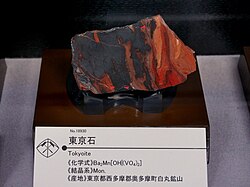Tokyoite
| Tokyoite | |
|---|---|
 Tokyoite ore displayed at the Mining Museum of Akita University, Japan | |
| General | |
| Category | Vanadate mineral |
| Formula (repeating unit) | Ba2(Mn3+,Fe3+)OH(VO4)2 |
| IMA symbol | Tky[1] |
| Strunz classification | 8.BG.05 |
| Crystal system | Monoclinic |
| Crystal class | Prismatic (2/m) (same H-M symbol) |
| Unit cell | a = 9.104 Å, b = 6.132 Å c = 7.895 Å; β = 112.2°; Z = 2 |
| Identification | |
| Color | Reddish black |
| Crystal habit | Occurs as splotchy, anhedral crystals forming inclusions |
| Cleavage | None observed |
| Mohs scale hardness | 4.5 - 5 |
| Luster | Vitreous |
| Streak | Deep brownish red |
| Diaphaneity | Translucent |
| Specific gravity | 4.62 calculated |
| Optical properties | Biaxial (?) |
| Refractive index | a=1.99, g=2.03 |
| Birefringence | 0.0400 |
| Pleochroism | Distinct, reddish orange to dark brownish red |
| References | [2][3][4] |
Tokyoite is a rare barium manganese vanadate mineral with the chemical formula: Ba2(Mn3+,Fe3+)OH(VO4)2. It is the manganese analogue of the iron rich gamagarite[3] and the barium analogue of the lead vanadate, brackebuschite.[4]
It occurs in low-grade metamorphosed sedimentary manganese ore deposits[2] associated with hyalophane, braunite and tamaite.[4]
It was first reported for an occurrence in the Shiromaru Mine, Okutama, Tama district, Tokyo Prefecture, Kantō region, Honshu Island, Japan and approved by the IMA in 2003.[3] It has been found in two mines in Italy and one in Japan, for which it was named.[2]
References
- ^ Warr, L.N. (2021). "IMA–CNMNC approved mineral symbols". Mineralogical Magazine. 85 (3): 291–320. Bibcode:2021MinM...85..291W. doi:10.1180/mgm.2021.43. S2CID 235729616.
- ^ a b c Mindat
- ^ a b c Webmineral data
- ^ a b c Matsubara, Satoshi, et al., Tokyoite, Ba2Mn3+(VO4)2(OH), a new mineral from the Shiromaru mine, Journal of Mineralogical and Petrological Sciences, V. 99, pp. 363-7, 2004
